The 10 Best Flea Shampoos for Cats in 2026
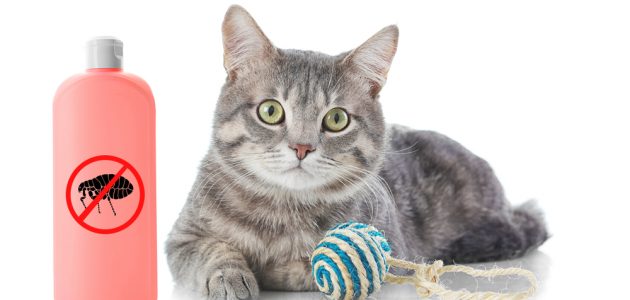
Fleas are one of the most common and irritating pests a pet owner can experience. Once sighted in your cat’s fur, you will have to act fast to prevent a full-blown infestation. Thankfully, there are many flea treatment products available today that can help you and your feline friend in waging war against this itchy parasite.
One excellent way to exterminate fleas is to bathe your cat in a flea shampoo. These shampoos can kill fleas, and prevent more fleas from seeking shelter in your pet’s fur. They come in a variety of different formulas, from organic and plant-based to chemically derived, and can even be waterless for cats that absolutely refuse to get their paws wet.
It can be hard to select the best flea shampoo for you and your pet when there are so many options available today, so we’ve put together a list of the top 10 best flea shampoos to help you out. Our list guides you through the different types of shampoos and their benefits, so you can easily decide which one is ideal for your feline companion. If you want a short primer before getting to list itself, read on.
- How Does Flea Shampoo Work?
- Top 10 Best Flea Shampoos for Cats 2026
- 1. Best Overall Flea Shampoo for Cats: Adams Plus Flea and Tick Shampoo
- 2. Best Premium Flea Shampoo: Veterinary Formula Clinical Care Shampoo
- 3. Best Budget Cat Shampoo for Fleas: John Paul Pet Oatmeal Shampoo
- 4. Best Flea Wipe: Vet’s Best Flea and Tick Wipes
- 5. Best for Sensitive Skin: Burt's Bees for Cats Hypoallergenic Shampoo
- 6. Best Strong Waterless Shampoo: Vet’s Best Flea and Tick Waterless Foam Shampoo
- 7. Best Shampoo for Maintenance: Advantage Flea and Tick Treatment
- 8. Best Scent: Sentry PurrScriptions Flea and Tick Shampoo
- 9. Best for Conditioning: Zodiac Flea and Tick Shampoo
- 10. Best Lather: Fresh 'n Clean Flea and Tick Conditioning Shampoo
- Your Full Guide to Cat Flea Treatment
- Why Being Flea-Free Is Important
- Checking Your Cat for Fleas
- Performing a Flea Test
- How Often Should Flea Shampoo Be Used?
- Does My Cat Need to Be a Certain Age?
- Can Dog Flea Shampoo Be Used on Cats?
- How to Properly Bathe Your Cat Using Flea Shampoo
- Stopping the Flea Cycle
- Natural Alternatives to Flea Proof Your Home
- Achieving a Flea-Free Life
How Does Flea Shampoo Work?
Flea shampoos are formulated with a number of different chemicals or plant extracts that act to kill fleas, and sometimes ticks, that are found on your cat. These active ingredients target fleas by either smothering them or attacking their nervous system. Once the fleas are dead, you can brush them out of your cat’s fur.
Some shampoos may leave a residue behind on your pet’s coat. The smell and/or feel of it will continue to repel fleas for anywhere between a day and a couple of weeks. This helps you combat the flea life cycle and prevents future infestations.
Benefits of Using Flea Shampoo
While not a guaranteed cure-all for a flea infestation by themselves, when partnered with an intensive house cleaning regime, flea shampoos can aid you in getting a situation under complete control. Shampoos are available that kill all life stages of fleas from eggs to adult, and can kill other parasitic pests, like ticks. Our best overall shampoo, Adams Plus, is perfect for eliminating fleas at all life stages.
Many flea shampoos can be used regularly as an alternative to a monthly preventative flea medication, and have ingredients that leave your cat’s fur feeling healthy and soft. They also help to soothe any skin that is irritated by flea bites (Burt’s Bees Flea Shampoo is great at this!), which is a bonus if you are using the shampoo as a part of a treatment plan.
Things to Consider in Flea Shampoo
Flea shampoos have a wide range of ingredients and formulas that may or may not suit your cat. It is important to consider your individual pet’s needs when purchasing a shampoo to make sure you are both happy with the purchase.
Type of Shampoo
There are three main categories of shampoo that are defined by their active ingredient. When selecting a shampoo, consider your cat’s skin type and level of flea infestation before using.
Chemical Shampoos
This is the strongest type of shampoo. They are created using pyrethrin or pyrethroids that attack fleas’ nervous systems. They are harsher on your cat’s skin and should be used with caution, but if you have an out-of-control infestation, they are strong enough to help you regain order.
Organic Shampoos
The active ingredients in organic shampoos are essential oils. These oils, most commonly peppermint and clove, are safe for use on your cat in small amounts and make a good preventative option. They are usually not strong enough to kill all the fleas on your cat, but the scent of the oils will repel future fleas from hitching a ride.
Natural Shampoos
Natural shampoos are often blended with d-limonene, a chemical extracted from citrus peel that kills fleas by attacking their nervous system. They can also be blended with ingredients such as aloe, coconut oils, and chamomile extracts. Natural shampoos are safe for cats, dogs, and humans, and can be a great option for both preventative flea care and infestation treatment.
Toxicity Concerns
Pyrethrin or pyrethroids, often found as the main ingredient in chemically based flea shampoos, are an insecticide derived from chrysanthemum flowers. Pyrethrins are the naturally extracted substance and pyrethroids are man-made. The use of these chemicals is considered very safe for dogs, but can be risky for cats due to a feline’s liver structure and their inability to break down these chemicals.
When using a flea shampoo that contains pyrethrins or pyrethroids, always use one that is specifically formulated for cats. These contain lower levels of pyrethrin/pyrethroids and are safer for use. Exposure to these chemicals in larger quantities that are meant for dogs can result in your cat being poisoned.
Use pyrethrin/pyrethroid based shampoos sparingly, and no more than once every few weeks. During bath time, be very careful that it does not go into your cat’s ears, eyes, or mouth, and be extremely thorough when rinsing off the shampoo to prevent accidental ingestion.
It should also be noted that you should not be using more than one flea shampoo at the same time. The pyrethrins may react with other substances in natural or organic shampoos, or they may be amplified by another shampoo using pyrethrins/pyrethroids, making them toxic to your cat.
Shampoo Formula
The type of shampoo you purchase depends on your cat’s tolerance level. If you think you can get them in a bath, you may want to go with a regular lathering shampoo. Regular shampoos are best for heavy-duty flea eradication and treatment, but not the best if you are planning on preventative care – your cat will likely not appreciate a monthly bath.
Waterless shampoos are designed as either a foam or a wipe. Foams, like Vet’s Best Waterless Foam Shampoo, are good option for cleaning your cat’s fur as well as for use as a monthly treatment. Waterless shampoos are more likely to be tolerated on a routine basis.
A flea wipe, such as Vet’s Best Wipes, is great for maintenance between monthly flea treatments or for preventative care.
Now that we’ve discussed the most important things to consider in a flea shampoo, let’s head straight into our list!
Top 10 Best Flea Shampoos for Cats 2026
1. Best Overall Flea Shampoo for Cats: Adams Plus Flea and Tick Shampoo

Editor’s Rating:
Why we like it: Blended with a sensitive skin formula and guaranteed to help kill fleas on your cat for up to 28 days, Adams Plus is a great choice for providing your pet with satisfying, itch-free relief.
At a Glance:
- Type of Shampoo: Chemical
- Active Ingredients: Pyrethrins
- Formula: Regular
Adams Plus is blended with their trademarked Insect Growth Regulator. This ingredient stays on your cat’s coat after their bath and kills any fleas that happen to jump on them in the next 28 days. It targets all stages of fleas, from eggs to adult, and is a great choice if you need to give you cat relief while you work on eliminating fleas from around your home.
This shampoo is good for multi-pet homes. It can be used on both dogs and cats, so if you need to address flea issues on all of your pets, this product is worth investing in. It also has a formula blended to help sensitive skin, with aloe added to soothe any areas bitten by fleas. If your cat’s sensitive skin is the main concern for you, be sure to check out Burt’s Bees Hypoallergenic Shampoo.
Adams Plus is formulated with pyrethrins. These can be too strong for some animals, and may cause seizures in some pets. Always check with a vet and do a small patch test on your cat before use to make sure the product is tolerated. You should not use this shampoo in your cat that has known health conditions or on an older cat, because they may not be able to tolerate the chemicals.
Pros
- Prevents flea hatching and kills fleas for up to 28 days
- Good for multi-pet homes
- Aloe helps soothe skin
Cons
- Cannot be used on older or unhealthy pets

Editor’s Rating:
Why we like it: Designed by veterinarians and PH balanced, this shampoo features naturally derived cleansers so your pet is pampered and flea-free.
At a Glance:
- Type of Shampoo: Chemical
- Active Ingredients: Pyrethrins
- Formula: Regular
This shampoo is designed by veterinarians and is specially blended to work with your cat’s fur. Each ingredient is medical-grade, so you can be sure about the safety of the product, especially since it is a chemical shampoo.
The formula is free of both harsh soaps and parabens, and is PH balanced. This helps stop the shampoo from drying out your pet’s skin and ensures that their fur is left soft and silky after bathing. It is great if your cat is prone to skin issues or has dry, sensitive skin.
Unfortunately, this product doesn’t lather as well as its competitors. The texture is on the thinner side and while it covers the coat, it can be hard to tell if you are massaging it in enough due to the lack of lather. Fresh ‘n Clean has the best lather out of the shampoos on our list, if that is an important factor to you.
The Clinical Care shampoo only kills adult fleas on contact, and may not help to repel fleas from your cat’s coat after using it. It may not be the best choice if you are battling a large flea infestation.
Pros
- PH balanced
- Soap and paraben-free
- Designed by vets with medical-grade ingredients
Cons
- Doesn’t lather well
- Only kills adult fleas
3. Best Budget Cat Shampoo for Fleas: John Paul Pet Oatmeal Shampoo
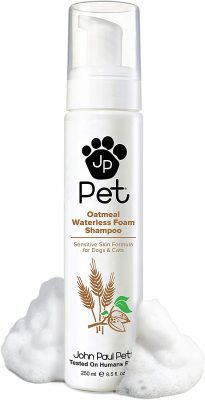
Editor’s Rating:
Why we like it: This waterless foam is perfect for refreshing and cleaning your pet, all while soothing their skin with oatmeal and aloe.
At a Glance:
- Type of Shampoo: Natural
- Active Ingredients: Oatmeal, Aloe, Chamomile
- Formula: Waterless Foam
This waterless foam is fantastic for using when your cat refuses to take a regular bath. The foam mixes with any dirt or excess oil on your pet’s fur and can be combed out, leaving the fur completely clean. There is no need to rinse their fur after using.
This product is affordable and highly concentrated. A little can go a long way when using this shampoo, which makes it a great choice for pet parents who are on a budget. The shampoo is blended with oatmeal, aloe, and chamomile, all of which can help soothe itchy spots left by flea bites.
The John Paul Pet Shampoo is not formulated to kill fleas on contact. This makes it a bad choice if you are trying to get an invasion under control; however, it does make a good choice for maintenance and for soothing your cat’s skin after flea treatments. For a waterless shampoo that does have the ability to fight fleas, look at Vet’s Best Waterless Foam Shampoo.
You should also keep in mind that this shampoo contains preservatives that may cause allergic reactions in your pets. If your cat is prone to allergies or has especially sensitive skin, you may want to stay away from this shampoo. Always do a patch test on a small area of your cat’s fur to make sure the product is tolerated well before applying it to the entire body.
Pros
- Affordable
- Formula blended with oatmeal, aloe, and chamomile
- Foam mixes with dirt to leave fur clean
- Highly concentrated; a little goes a long way
Cons
- Does not kill fleas on contact
- Contains preservatives that may cause allergic reactions
4. Best Flea Wipe: Vet’s Best Flea and Tick Wipes
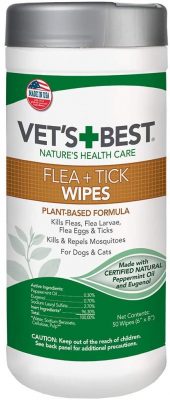
Editor’s Rating:
Why we like it: Vet’s Best Flea Wipes are easy to use and great for spot application, so you can target your cat’s itchiest areas.
At a Glance:
- Type of Shampoo: Organic
- Active Ingredients: Peppermint Oil, Eugenol
- Formula: Wipes
These wipes are designed to kill fleas and flea eggs on contact. They are great if you need to do spot treatments on your cat, because you can take the wipe to the area that is most bothering them and eradicate the fleas there. It is also good if your cat doesn’t tolerate baths well.
The scent from these wipes helps to repel mosquitos and ticks. This is a bonus if your cat frequently takes adventures outside of the home. Vet’s Best uses a completely plant-based formula blended with essential oils, making it a good alternative to chemical-based flea products.
The smell of the essential oils in this product can be overpowering. If you are sensitive to smell and don’t want this scent lingering on your cat, maybe try out our best-scented shampoo Sentry PurrScriptions instead.
Eugenol, also known as clove oil, can be toxic to some cats. You should not apply this anywhere your cat can reach to lick and then accidentally ingest. Some pets tolerate this oil better than others, but you should ask a vet before using this product to make sure it is safe for your pet.
Pros
- Plant-based formula
- Repels mosquitos and ticks
- Kills fleas and flea eggs on contact
- Easy to use
Cons
- Eugenol can be toxic to some cats
- Overpowering scent
5. Best for Sensitive Skin: Burt's Bees for Cats Hypoallergenic Shampoo

Editor’s Rating:
Why we like it: 99 percent natural and safe for all cats and kittens, Burt’s Bees Hypoallergic Shampoo is a fantastic option for cleansing and calming your cat’s skin.
At a Glance:
- Type of Shampoo: Natural
- Active Ingredients: Honey, Shea Butter
- Formula: Regular
Burt’s Bees is known for making high-quality natural products and their cat shampoo is no different. Created with 99.7 percent natural ingredients, this shampoo is hypoallergenic and safe for cats and kittens. This is great if you have multiple ages of pets in your home and want a product that can be used on all of them.
The addition of shea butter and honey help to make this shampoo extra moisturizing. Honey adds shine to the fur, while shea butter works to treat any itchy spots your cat has. It is also blended without fragrances, sulfates, or essential oils, making it a good option for a sensitive cat.
This product does not kill flea eggs and is not blended with any especially potent flea-killing ingredients. However, because it is a soap, you may have luck using it to kill adult fleas and as a maintenance treatment.
Pros
- 99 percent natural ingredients
- Hypoallergenic
- Moisturizing shea butter and honey
- Fragrance, sulfates, and essential oil free
Cons
- Doesn’t kill flea eggs
6. Best Strong Waterless Shampoo: Vet’s Best Flea and Tick Waterless Foam Shampoo

Editor’s Rating:
Why we like it: A foam shampoo similar to John Paul’s waterless shampoo, Vet’s Best kills fleas in all life stages with no need for water.
At a Glance:
- Type of Shampoo: Organic
- Active Ingredients: Peppermint Oil, Eugenol
- Formula: Waterless Foam
This foam shampoo is fast-acting. As soon as you apply it to your cat’s fur, both adult fleas and flea eggs will be killed on contact so you can easily brush them out. The formula is also quick-drying; as you massage it into your cat’s fur, they won’t be bothered by excessive wetness or greasiness.
Like with other waterless shampoos, there is no water needed before or after use of Vet’s Best. It is a great option for any pet that hates getting their fur wet. It can also be used to spot treat certain areas of your cat’s fur that may be more prone to fleas and ticks.
As we mentioned in our review of Vet’s Best Wipes, Vet’s Best uses a combination of essential oils in their flea products. Eugenol, and occasionally peppermint oil, may be dangerous to some cats, so use this product sparingly and consult with a vet before use.
This waterless shampoo does have a slightly thick consistency that can make it hard to spread evenly throughout your cat’s fur. It may also be a little sticky when not massaged in properly. For a more conditioning shampoo that leaves the fur soft, we recommend Zodiac Flea Shampoo.
Pros
- No water needed
- Kills fleas of all life stages
- Fast-acting
Cons
- Essential oils may be dangerous to some pets
- Thick consistency
7. Best Shampoo for Maintenance: Advantage Flea and Tick Treatment

Editor’s Rating:
Why we like it: Made by the same company that develops topical flea treatments, Advantage Flea Treatment is a basic, unscented flea shampoo great for monthly maintenance.
At a Glance:
- Type of Shampoo: Chemical
- Active Ingredients: Pyrethrins
- Formula: Regular
For over 100 years, Bayer DVM has worked with veterinarians to develop quality pet health products. Advantage Flea Treatment shampoo is in the same brand line as its Advantage topical flea treatments and works to quickly kill fleas and ticks. As soon as it is applied, you will see fleas attempting to escape from your cat’s fur.
This product is great for monthly maintenance if you don’t want to administer topical treatments. It is effective and easy to use. It also has an unscented formula, which is great if you or your cat are sensitive to fragrances or odors and you wish to avoid them.
You do need to be careful when applying this product. Adding too much at one time or applying too often can cause allergic reactions or chemical burns to appear on your pet. Make sure to read the instructions before use, and don’t apply more than once every few weeks.
If you want a shampoo you can use more often, we recommend Burt’s Bees Hypoallergenic Shampoo.
Pros
- Unscented formula
- Great for monthly maintenance
- Quickly kills fleas and ticks
Cons
- May cause chemical burns if used too often
8. Best Scent: Sentry PurrScriptions Flea and Tick Shampoo
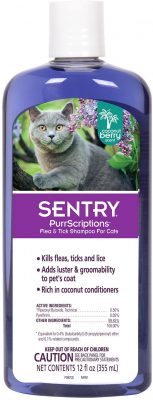
Editor’s Rating:
Why we like it: Sentry PurrScriptions Flea Shampoo has a long-lasting berry scent that will leave your cat smelling fresh for days.
At a Glance:
- Type of Shampoo: Chemical
- Active Ingredients: Pyrethrins
- Formula: Regular
This shampoo can kill lice as well as fleas and ticks; it is a good choice if you are looking for a shampoo that can help you rid your cat of all types of pests at the same time. Fleas are killed on contact as soon as you begin lathering the shampoo and are easily rinsed off as a result.
Sentry PurrScriptions shampoo has a long-lasting coconut berry scent. After washing, your cat will smell fresh for days. It is a great option if you want your cat to smell good days after they’ve had a bath. The formula also has added coconut conditioners to make your pet’s fur shiny; consistent use will add significant luster to their fur.
The consistency on this shampoo is rather thin, and it can be a little watery. This makes it hard to massage into your cat’s fur. If you want a shampoo that is equally as conditioning with a slightly thicker texture, look at Zodiac’s Flea Shampoo.
Pros
- Kills lice as well as fleas and ticks
- Long-lasting coconut berry scent
- Coconut conditioners make fur shiny
Cons
- Thin consistency
9. Best for Conditioning: Zodiac Flea and Tick Shampoo

Editor’s Rating:
Why we like it: Zodiac’s conditioning formula will leave your cat with tangle free fur and can repel fleas for up to two weeks after use.
At a Glance:
- Type of Shampoo: Chemical
- Active Ingredients: Pyrethrins
- Formula: Regular
Zodiac Flea and Tick shampoo features a conditioning formula that uses coconut conditioners, much like Sentry PurrScriptions. However, Zodiac’s formula is slightly stronger, and more deeply conditions fur. It is especially good for leaving long-haired cats tangle-free after bath time.
This product repels fleas for up to two weeks after use. It is good for both treatment of a larger flea infestation and the prevention of fleas. If you like the idea of a product that keeps working even after bath time, be sure to also look into Adams Plus.
Zodiac is a little more potent than other chemical-based shampoos. This may make it a bad choice for pets with sensitive skin, or if you are trying to stay away from strong chemical products. We recommend something like John Paul’s Waterless Shampoo if you are trying to avoid too many harsh chemicals in your cat shampoo.
Pros
- Conditioning formula
- Repels fleas for up to two weeks
- Leaves fur tangle-free
Cons
- More potent than other shampoos
- Not good for sensitive skin
10. Best Lather: Fresh 'n Clean Flea and Tick Conditioning Shampoo
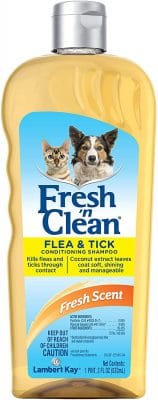
Editor’s Rating:
Why we like it: This flea shampoo lathers up well and has a gentle formula, perfect for de-fleaing small cats and kittens.
At a Glance:
- Type of Shampoo: Chemical
- Active Ingredients: Pyrethrins
- Formula: Regular
While still chemically-based, this formula has a slightly lower percentage of chemicals than other flea shampoos. This makes it more gentle for use on your cat; it is a great option for bathing smaller cats and kittens because of this formula.
This shampoo lathers up well and is easy to massage into your cat’s fur. It attacks fleas and ticks, killing them on contact, and leaves behind soft, silky fur. The scent left behind by this shampoo can be freshened up by spritzing the fur lightly with water.
Due to its lighter chemical formula, it isn’t the best for severe flea treatments, and may not kill lots of fleas upon use. If you are looking for a stronger product that is guaranteed to take care of a larger flea problem, check out Adams Plus flea shampoo.
Pros
- Great lather
- Works well for smaller cats
- Gentle formula
- Scent can be refreshed
Cons
- Not the best for severe flea treatment
Your Full Guide to Cat Flea Treatment

Treating your cats for fleas can be an overwhelming and concerning process; you want your cats to be itch-free and you want your home to be rid of pesky fleas. Our full guide below will give you all the information you need to understand cat flea treatment, and help you create some natural flea remedies.
Why Being Flea-Free Is Important
Being flea-free is important for both comfort and health reasons. Nobody wants to be relaxing at home, minding their business, when all of a sudden, they start getting bitten by fleas. These parasites are troublesome home invaders; they can infiltrate your home silently, and before you know it, both you and your cat are itchy and uncomfortable.
Fleas can transmit a number of diseases with their bite to both humans and animals. These diseases include typhus, cat scratch fever, tapeworms, and the plague. Maintaining a flea-free environment means you won’t have to risk becoming sick, or having your cat fall ill, to any of these illnesses.
Checking Your Cat for Fleas
As soon as you can easily see fleas on your cat, you likely have a full-blown infestation out of sight. Only 5 percent of fleas, mostly the adults, are visible to you, with the other 95 percent hidden in your environment. This 95 percent consists of eggs, larvae, and pupae; they are typically found deep in your carpet, clothing, and furniture.
Checking your cat regularly for fleas can help stop an infestation before it reaches epic proportions, and consequently becomes far harder to manage. There are a few signs you can look out for that will help you get the jump on these bothersome parasites.
Skin Abnormalities
If your cat begins losing hair, or develops scabs and bumps, it could be a sign of fleas. However, make sure to consult with a vet if this is your pet’s only symptom to rule out any medical issues.
Excessive Grooming
Cats typically spend 10 percent of their time awake grooming themselves. But when your cat begins spending excessive time licking, scratching, or biting at certain areas of their body, they may have fleas.
Anemia
This usually only happens in extreme cases of flea infestation. If your cat has extreme lethargy along with pale gums, they may have flea-induced anemia. Kittens are especially predisposed to this due to their small bodies.
Behavioral Changes
Your cat may become restless or aggressive with you as they deal with the discomfort of constantly being bitten. They may also avoid certain areas of your house where they find the fleas to be more concentrated.
Tapeworms
This is not as common as other symptoms, but it is still wise to look out for it. If you see short, crawling segments that populate your cat’s feces, they have tapeworms; fleas transmit tapeworms, so there is a good chance your cat will have them too.
Performing a Flea Test
If your cat is exhibiting one of more of these signs and you want to be sure of the presence of fleas, you can perform a simple confirmation test.
- Place your cat onto a white towel. This color both attracts fleas and lets you see them more clearly if they jump off your cat.
- Comb them with a fine-toothed comb or a flea comb. Start at the head and look for any signs of flea dirt, eggs, or adult fleas on the comb. Pay close attention to the skin beneath the fur and check for any signs of scabs or skin irritation.
You can check for flea dirt by wiping your comb on the towel and adding a little water. If a rusty-red color shows through, you are dealing with fleas. The red color is a result of the fleas’ blood-centric diet.
If fleas, eggs, or flea dirt are sighted during this process, it is time to begin flea infestation treatment. Determine the extent of the invasion and purchase a flea shampoo accordingly. You should also begin making plans to deep clean your house. Remember, the longer you leave it, the harder it will be to eliminate every single flea from your pet and home.
How Often Should Flea Shampoo Be Used?
How often you can use flea shampoo depends on the type of shampoo you buy. Most chemical shampoos are designed to only be used once a month due to their harsh nature. Other natural and organic shampoos can be used every week or so, or even every couple of days as part of a maintenance routine. Vet’s Best Wipes, for instance, may be used once every 24 hours.
Always be sure to read all instructions and check your cat for any allergic reactions when applying flea products. If your cat has especially sensitive skin, you may want to wait longer between applications to avoid irritation. Symptoms such as a skin rash, itching, or sneezing can indicate an allergic reaction. Monitor your pet closely and contact a vet if the symptoms do not disappear within a few hours, or become life-threatening.
Does My Cat Need to Be a Certain Age?
Most flea shampoos state that your cat needs to be above 12 weeks for use. This is because small kittens cannot handle chemicals and essential oils in the same fashion that older cats can. If your kitten needs flea treatment or prevention, look for shampoos that are formulated specifically for cats younger than 12 weeks or use a natural flea remedy on them.
Can Dog Flea Shampoo Be Used on Cats?
You should never use flea shampoo designed for dogs on your cats, especially if they are chemical shampoos. As we discussed in our mini-guide, the number of chemicals and essential oils in dog shampoos would be too much for a cat’s body to handle and you may end up poisoning your cat.
Shampoos that are marketed for use by both cats and dogs may be safe to use; these generally have a lower quantity of chemicals in them to make them safe for both animals. If you are concerned about safety, your best bet is to pick up a flea shampoo specifically designed for cats, so you don’t have to worry.
How to Properly Bathe Your Cat Using Flea Shampoo
Bath time may not be a pleasant activity for you and your cat, but if you have a serious flea problem, it is a necessary part of the removal process. We’ve gathered some tips to help you make your kitty’s bath a little easier, and hopefully protect you from their claws.
Each shampoo will be slightly different in terms of directions and how much you should be applying to your cat. Make sure to read and understand the instructions before using it.
- Brush your cat to remove any loose hair and mats. This can also help to dislodged fleas and flea dirt.
- Place your cat in a tub filled with two to three inches of lukewarm water. Make sure the water is not scalding hot, but not too cold.
- Use your hands, a cup, or a spray bottle to thoroughly wet your cat’s fur, being careful to avoid ears, eyes, and mouth. You can use a washcloth to gently wipe the face.
- Working from top to bottom, apply the flea shampoo and gently massage it in. Pay special attention to the insides of legs, behind the ears and neck, and the base of the tail as these are a flea’s favorite hiding places. Do not apply or lather up the shampoo around the cheeks, ears, or eyes of your cat.
- Give the shampoo time to work. Your cat may not like it, but they will have to stay put for around 5 minutes to give the shampoo time to work. Try giving them praises and gentle pats to keep them calm.
- Use a flea comb to work through your cat’s fur while they are lathered up. This helps capture all fleas that may be trying to escape. You can place these fleas in a separate bowl of soapy water to ensure they don’t attempt to jump back onto your cat; the soap will prevent them from jumping.
- Rinse your cat Use your hand or a washcloth to wipe any shampoo off of their head, and make sure there is no residue left in their fur. You don’t want to leave any shampoo that your cat may lick off after their bath.
- Dry your cat. You can use a towel to rub them down or a dryer set on low heat if they tolerate the noise. When drying a long-haired cat, you may have to brush out and detangle their fur.
For best bathing results, try to tire your cat out before bath time; engage them in an extended playtime with their favorite toys. You may also want to clip their nails a day or two before their scheduled bath.
If you’re certain that your feline friend is absolutely not going to tolerate being bathed, look into using waterless shampoo or flea wipes.
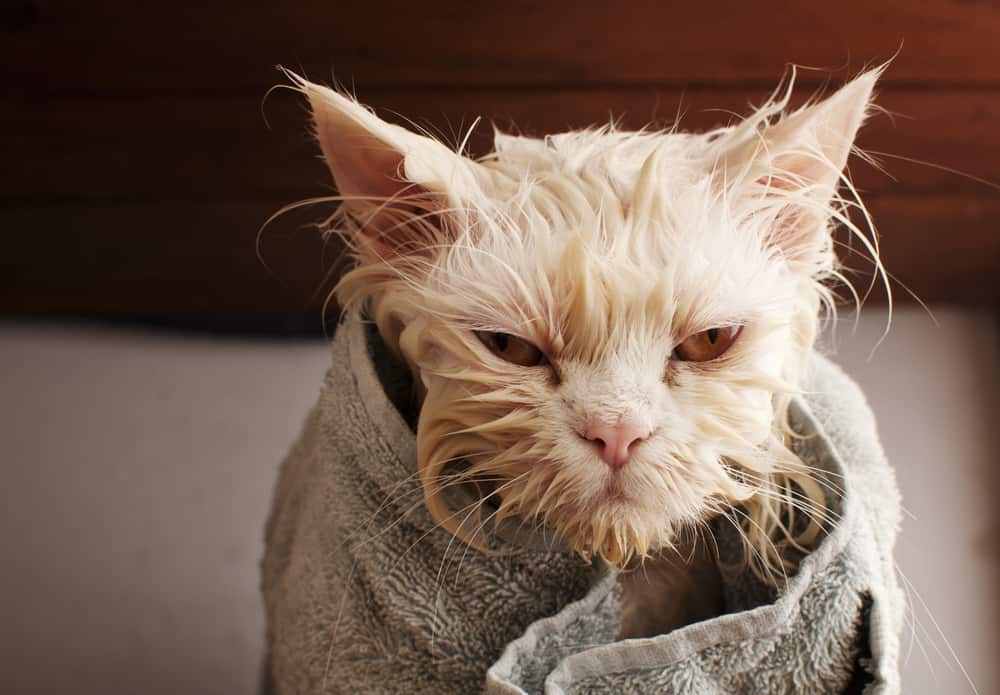
Stopping the Flea Cycle
Fleas can be so tricky to eliminate because of their size and life span. The key to completely removing them is to understand their life cycle and coordinate your cleaning accordingly.
The Life Cycle of a Flea
There are four stages in a flea’s life: egg, larvae, pupae, and adult. To successfully beat a flea infestation, you must target all of these stages, not just the adults.
Flea eggs can be found either on your pet or buried in your carpet. They can stay hidden as long as 200 days, waiting for the right hatching conditions. In good conditions, they will hatch into larvae in 10 days, and turn into pupae another 10 days after that.
Before pupae transition to adults they create a cocoon; they will stay there for a day or two, but can stay up to 6 months depending on the time of year. Once they are adults, female fleas can lay around 50 eggs a day, further perpetuating the cycle.
Overall, the flea cycle lasts anywhere between 2 and 4 weeks. This is why preventative care and routine cleaning is so important to beat a large infestation. If you only kill the adult fleas, two weeks later, you will have to start all over again.
In a severe flea invasion, we recommend a flea shampoo like our best overall pick Adams Plus, which will help repel and kill fleas for up to 28 days – enough to stop the flea life cycle from continuing.
Cleaning
Besides equipping your pet to fight fleas, cleaning is one of the most important things to do if you want to permanently eliminate fleas in your home.
Vacuum all carpets once a week, or every few days in severe cases. Vacuuming has been proven to kill up to 96 percent of the adult fleas it traps, and 100 percent of younger fleas. It also removes environmental factors that fleas feed on, such as dirt and dead hair and skin cells. A strict vacuuming routine will rid your carpets of fleas in no time.
To eliminate any remaining fleas, wash your bedding and your cat’s bedding once a week. The hot water in the washing machine will kill fleas of all life stages that may be hiding in your sheets. You can also use a flea wipe on your pet’s bedding after it has been washed to repel fleas away from the area.
Natural Alternatives to Flea Proof Your Home
While there are many chemical products available today that can help you turn the tables on a flea infestation, you may prefer to go a more natural route out of safety concerns for your household and your pet. Thankfully, there are several natural alternatives that are just as effective as using chemical products in your home.
Homemade Flea Trap
When combined with vacuuming, this homemade flea trap is perfect for eliminating fleas.
- Fill a large, shallow bowl with water. You don’t want to sides to be too high or the fleas will not easily jump into it.
- Add a little bit of dish soap and agitate the bowl to distribute the soap. Soap reduces the surface tension of the water so that fleas will sink and drown when they jump in, unlike with regular water which they can jump out of.
- Lay down a towel to catch spills wherever you place the bowl. Leave it in an area popular with fleas, such as near pet bedding, along the edges of carpet, and around pillows and furniture.
- Add a lamp or plant near the bowl to attract fleas. The lamp adds warmth and light, which fleas are drawn to. They will come near it and jump into the bowl. Plants give off carbon dioxide, a great attractor for flea pupae. A houseplant near the bowl can help take out these fleas before they become adults.
- Leave the bowl overnight. Fleas are the most active just after sunset until sunrise, so leaving the bowl out overnight will catch you the most fleas.
Each morning, check the bowl for fleas and change out the water. Keep repeating this process until you don’t see fleas in the water anymore. It is a good idea to leave multiple bowls throughout the house and adjust their placement as needed. Make sure your cat doesn’t try to drink out of the bowls at any time.
Homemade Flea Treatment for Cats
If you aren’t a fan of using chemical shampoos on your cat, you can concoct flea treatments using natural ingredients from around your home to give your furry friend some relief.
Use Lemon Juice
Citric acid, which is found in lemon juice, is a known killer of fleas. To use this method, boil one or two cut lemons in water and let them steep for several hours. Transfer the cooled liquid to a spray bottle and lightly apply it to your cat’s fur, working it in gently. Make sure to look for any signs of skin irritation when using lemon juice.
Wash Your Cat With Dish Soap
Dish soap breaks down a flea’s exoskeleton, effectively killing them. Using a gentle dish soap in the bath in place of a shampoo can be very effective. However, dish soap can be drying to a cat’s skin, so you probably don’t want to use this method often.
Spice up Their Food
Cumin is a spice known to be tolerated by cats. When eaten, it makes their skin taste very unappealing to fleas. Only add a little bit to the top of your kitty’s food, never any more than a teaspoon. It may take a while for this method to take effect, so it is best used as a regular maintenance or prevention technique.
These treatments are great alternatives to using chemical products on your cat. Make sure to check with a vet before using any of them, and monitor your cat during use to make sure they tolerate these methods.
Achieving a Flea-Free Life
Once you have fleas in your home, it can feel like life will never return to normal. A flea shampoo is an integral part of the flea removal process, and it can bring wonderful relief to your cat.
When purchasing a shampoo, always be sure to consider the ingredients and your cat’s individual needs to ensure you pick the best option. Combined with a careful cleaning routine, a flea shampoo will put you back on track to a flea-free life in no time.




